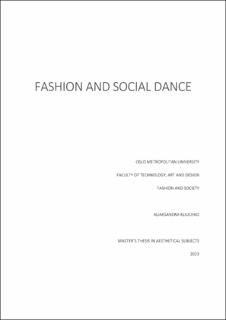| dc.description.abstract | The following research project takes into consideration the relation between the phenomenon of fashion and the phenomenon of social dance. The research question focuses on the motives behind the fashion choices of the participants of social dance events, and Argentine tango and swing are the social dances presented in the project. The research design which emerges based on the research question and the purpose of the research is based on the grounded theory and qualitative interviewing as the main methods of investigation. Grounded theory gives the possibility to focus on the inquiry as the main source of data, which is analysed and categorised further in the research. Grounded theory also gives the possibility to articulate and amplify the voices of the research participants. The inquiry data is gathered through the process of qualitative interviewing. Eighteen qualitative interviews were conducted and further analysed during the research project. The sample consists of nine female and nine male dancers. Ten of the interview participants are practitioner of swing dancing, and the other eight interview participants do practice Argentine tango. Interview participants have different level of experience within the scene of social dance, which varies between 3 and 31 years of active dancing. The information gathered during the process of qualitative interviewing is analysed through the process of initial and focused coding. The codes are in their turn organised into categories and concepts in order to present the actual findings and facilitate the process of discussion. The findings consist of three main concepts of self, group and occasion, where each category has several subcategories. The category of self presents the motives behind the fashion choices of the participants of social dance events based on the principles of self-construction, -projection and -communication. The role of clothing in construction of mood, feelings and dancer identity, as well as communication of this dancer identity and individuality to the dance peers, motivates informants to obtain to the fashion phenomenon through the concept of self. The category of group reveals the motives behind the fashion choices of the participants through the construction of their collective identity. The category of occasions discusses social dance events as the specific occasion, where the phenomenon of fashion in social dance practice can occur. The motives behind the fashion choices are seen based on different conditions within the occasion. The concept of gender and its performance through the practice of social dance within the motives behind the fashion choices of informants is also discussed in the discussion chapter. | en_US |
